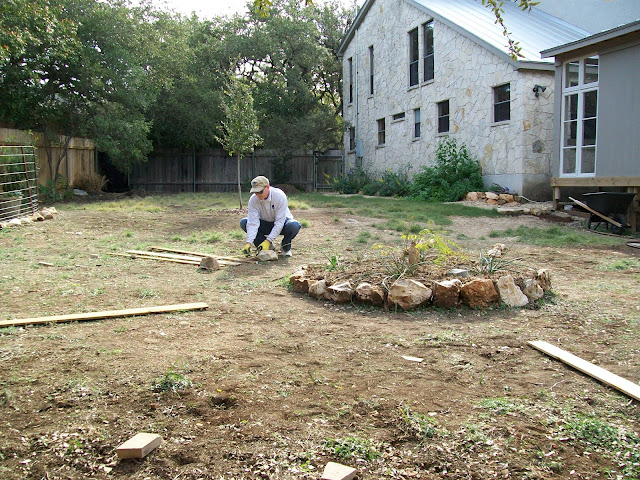While not exactly reinventing the wheel, this garden has reinvigorated a scruffy spot in the back yard and provided a nice sunny spot for growing native and adapted plants.
This area really began looking bad a year into the drought when the weeds died and the buffalo grass went dormant. It made a pretty good golf driving range though.
We built a shed and small garden in the corner and replaced the fence we shared with the neighbors. I planted wildflowers and we set up a temporary wire fence to help protect plants along the fence from deer browsing. In spring 2011, a few bluebonnets managed to take hold. My vision of a wildflower and native grass lawn wasn't working out too well just yet
By fall of 2011, the drought had obviously taken its toll. Even the weeds were struggling and thin soil over a rocky slope was not a good place to plant anything. A new approach was needed. We decided on a circle garden because terracing across the yard would have been too involved for a DIY project. The circle allows access from the shed to other parts of the yard and rain runoff goes around it or is used by the garden.
The 48" diameter center circle was laid out and planted in the fall of 2011. The surrounding wedges were added in the spring of 2012. Leftover fence boards were used to lay out the pathways. After the boards were in place, we walked through and around the circle changing the boards until the direction of the paths connected comfortably with other points in the yard. Over to the right a new screen porch fitted with salvaged windows is under construction.
We used rocks from the yard to line the beds and measured every few feet to make sure the beds stayed even. No point buying rocks when these are free and indigenous to the site. It's also a nod to the Hill Country tradition of lining paths and flower beds with found rocks.
The wedges were filled with top soil and compost.
This spring the bluebonnets looked great both in and around the circle.
The interior paths were lined with landscape fabric and then filled with gravel salvaged from the front yard. The plants are kept low to allow a view of the trees and creek from the gate. Far from being an impediment the circle has created a very pleasant plant and flower-filled transition to the shed. The gravel path from the deck is most helpful when it rains to keep shoes from getting muddy.
The circle is planted with ornamental grasses, native and drought tolerant perennials, and a few annuals. While the plantings are not precisely laid out they are tied together with Ruby Crystals grass (Melinus nerviglumis 'Savannah') planted at both ends of each wedge along the spokes of the wheels. Eventually the spokes will connect paths that lead to other areas of the yard and shed.
Now I look forward to seeing this area and occasionally walk out here just to stand in this garden.
Building this circle garden has made a huge difference in how we view the backyard.
It's so nice to have this garden finished. We have many more projects planned for the back yard so it will keep getting better from here on.


















































